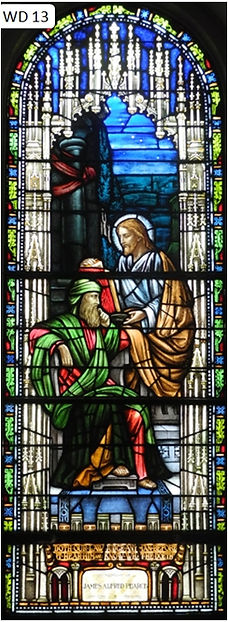The History of Emmanuel Church

WD13 Jesus and Nicodemus
(Pearce Window)
C. Willet Studiod, Philadelphia, 1920s


DESCRIPTION:
John tells us in his Gospel, chapter 17 verses 50 and 51: “Then Nicodemus, who came to Jesus before at night and was one of them, asked: ‘Doth our law judge any man, before it hear him, and know what he doeth?’ “ This windows depicts the scene with Nicodemus seated comfortably at Jesus’ feet. It is obvious from
the star-studded night scene in the window behind that this is one of Nicodemus’s secretive visits. The quote in the inscription was actually spoken by Nicodemus to the Chief Priests and his fellow Paharisees in defense of Jesus as they plotted against him.
Inscription: “Doth our law judge any man, before it hear him, and know what he doeth”
Namplete: "In Memopry of James Alfred Pearce April 2, 1840 ----- Dec 9, 1920"
HISTORY:
James Alfred Pierce was served on the Maryland Court of Appeals. His having been a lawyer might account for his choosing this subject for this window.) His father was a member of Congress and a U.S. Senator. He built the house on the corner of Water Street and Maple Avenue that served as Emmanuel’s rectory for almost sixty years (1922 – 1980). This is one of two windows known as the Pearce Windows, because they were endowed by the Pearce family during the 1920s.
They were produced by the Willet Stained Glass Company of Philadelphia. William Willet was a well-known stained glass artist who rebelled against the American School of stained glass – a movement established in part by Louis Comfort Tiffany -- identified by its use of opalescent glass (as seen in our Good Shepherd Tiffany window). Willet believed that opalescent glass ignored basic principles of architecture and did not fulfill the intended purpose of a window. Instead, he was enamored with the medieval technique of transparent antique glass, as seen in these two Pearce windows. He founded his own studio in 1899.